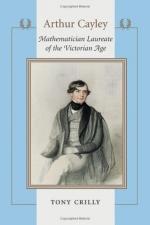|
This section contains 375 words (approx. 2 pages at 300 words per page) |
World of Scientific Discovery on Arthur Cayley
Cayley was born in England during a short visit of his parents to Richmond, Surrey, but spent his first eight years in Russia where his father plied a living as a merchant. Returning to England to attend a private school, Cayley eventually attended Trinity College, Cambridge where he excelled in mathematics and languages. He graduated in 1842 and was immediately awarded a Fellowship at the College but was prevented from remaining at Cambridge because of his reluctance to take up holy orders, which was a requirement at the time. He then studied law at Lincoln's Inn and took up legal practice in 1849.
Cayley's work as a lawyer did not hinder him from making major contributions to mathematics. For the fourteen years that Cayley practiced law he also wrote nearly three hundred mathematical papers (his lifetime total approached 1,000). During this period, Cayley met the mathematician James Joseph Sylvester (1814-1897) who also divided his time between law and mathematics. They both profited from their friendship, one result of which was the joint development of the algebraic theory of invariants, which was first begun in the work of Joseph Louis Lagrange. In 1863, Cayley took on the position of Sadlerian professor of pure mathematics at Cambridge, where he remained for the rest of his life.
The years that followed were very productive for Cayley. He developed a theory of n-dimensional, or multi-dimensional, geometry. The concepts of this non-Euclidean geometry were ultimately to bear fruit much later in the applications Albert Einstein made of it in his own general theory of relativity. Cayley also fully developed the algebra of matrices which had been introduced by Carl Gustav Jacob Jacobi (1804-1851). The particular innovation of Cayley's theory was that it did not require matrix-elements to be repeatedly referred to the equations from which they were taken.
Despite his many publications and prodigious efforts in the field of mathematics, Cayley was not a narrow-minded person with only a single interest. He was an excellent linguist, he travelled, climbed mountains, painted watercolors throughout his life and was interested in architecture. When he died in 1895 at the age of 73, Cayley was already famous and revered as a major contributor to mathematics and respected as one of the great intellects of the nineteenth century.
|
This section contains 375 words (approx. 2 pages at 300 words per page) |


